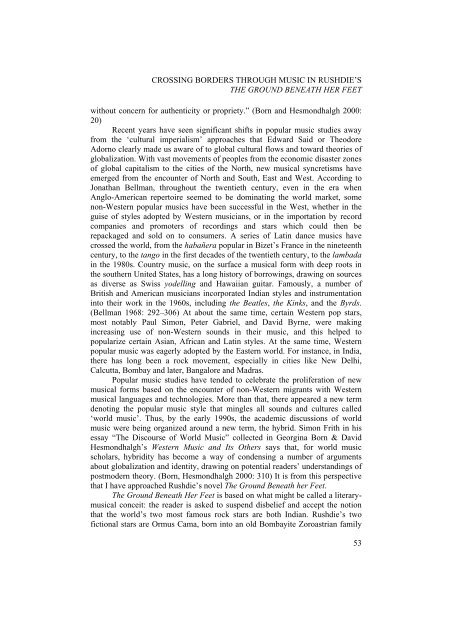culture, subculture and counterculture - Facultatea de Litere
culture, subculture and counterculture - Facultatea de Litere
culture, subculture and counterculture - Facultatea de Litere
Create successful ePaper yourself
Turn your PDF publications into a flip-book with our unique Google optimized e-Paper software.
CROSSING BORDERS THROUGH MUSIC IN RUSHDIE’S<br />
THE GROUND BENEATH HER FEET<br />
without concern for authenticity or propriety.” (Born <strong>and</strong> Hesmondhalgh 2000:<br />
20)<br />
Recent years have seen significant shifts in popular music studies away<br />
from the ‘cultural imperialism’ approaches that Edward Said or Theodore<br />
Adorno clearly ma<strong>de</strong> us aware of to global cultural flows <strong>and</strong> toward theories of<br />
globalization. With vast movements of peoples from the economic disaster zones<br />
of global capitalism to the cities of the North, new musical syncretisms have<br />
emerged from the encounter of North <strong>and</strong> South, East <strong>and</strong> West. According to<br />
Jonathan Bellman, throughout the twentieth century, even in the era when<br />
Anglo-American repertoire seemed to be dominating the world market, some<br />
non-Western popular musics have been successful in the West, whether in the<br />
guise of styles adopted by Western musicians, or in the importation by record<br />
companies <strong>and</strong> promoters of recordings <strong>and</strong> stars which could then be<br />
repackaged <strong>and</strong> sold on to consumers. A series of Latin dance musics have<br />
crossed the world, from the habañera popular in Bizet’s France in the nineteenth<br />
century, to the tango in the first <strong>de</strong>ca<strong>de</strong>s of the twentieth century, to the lambada<br />
in the 1980s. Country music, on the surface a musical form with <strong>de</strong>ep roots in<br />
the southern United States, has a long history of borrowings, drawing on sources<br />
as diverse as Swiss yo<strong>de</strong>lling <strong>and</strong> Hawaiian guitar. Famously, a number of<br />
British <strong>and</strong> American musicians incorporated Indian styles <strong>and</strong> instrumentation<br />
into their work in the 1960s, including the Beatles, the Kinks, <strong>and</strong> the Byrds.<br />
(Bellman 1968: 292–306) At about the same time, certain Western pop stars,<br />
most notably Paul Simon, Peter Gabriel, <strong>and</strong> David Byrne, were making<br />
increasing use of non-Western sounds in their music, <strong>and</strong> this helped to<br />
popularize certain Asian, African <strong>and</strong> Latin styles. At the same time, Western<br />
popular music was eagerly adopted by the Eastern world. For instance, in India,<br />
there has long been a rock movement, especially in cities like New Delhi,<br />
Calcutta, Bombay <strong>and</strong> later, Bangalore <strong>and</strong> Madras.<br />
Popular music studies have ten<strong>de</strong>d to celebrate the proliferation of new<br />
musical forms based on the encounter of non-Western migrants with Western<br />
musical languages <strong>and</strong> technologies. More than that, there appeared a new term<br />
<strong>de</strong>noting the popular music style that mingles all sounds <strong>and</strong> <strong>culture</strong>s called<br />
‘world music’. Thus, by the early 1990s, the aca<strong>de</strong>mic discussions of world<br />
music were being organized around a new term, the hybrid. Simon Frith in his<br />
essay “The Discourse of World Music” collected in Georgina Born & David<br />
Hesmondhalgh’s Western Music <strong>and</strong> Its Others says that, for world music<br />
scholars, hybridity has become a way of con<strong>de</strong>nsing a number of arguments<br />
about globalization <strong>and</strong> i<strong>de</strong>ntity, drawing on potential rea<strong>de</strong>rs’ un<strong>de</strong>rst<strong>and</strong>ings of<br />
postmo<strong>de</strong>rn theory. (Born, Hesmondhalgh 2000: 310) It is from this perspective<br />
that I have approached Rushdie’s novel The Ground Beneath her Feet.<br />
The Ground Beneath Her Feet is based on what might be called a literarymusical<br />
conceit: the rea<strong>de</strong>r is asked to suspend disbelief <strong>and</strong> accept the notion<br />
that the world’s two most famous rock stars are both Indian. Rushdie’s two<br />
fictional stars are Ormus Cama, born into an old Bombayite Zoroastrian family<br />
53












